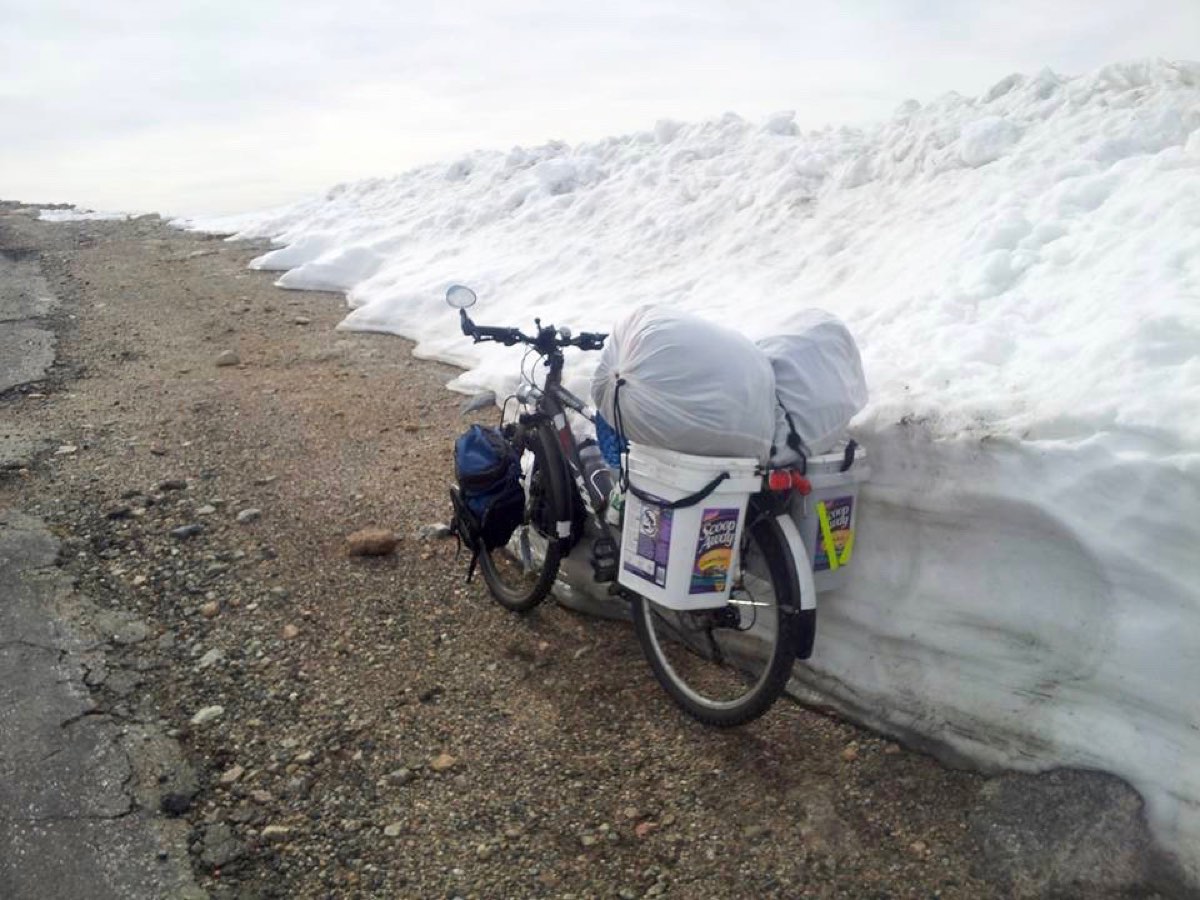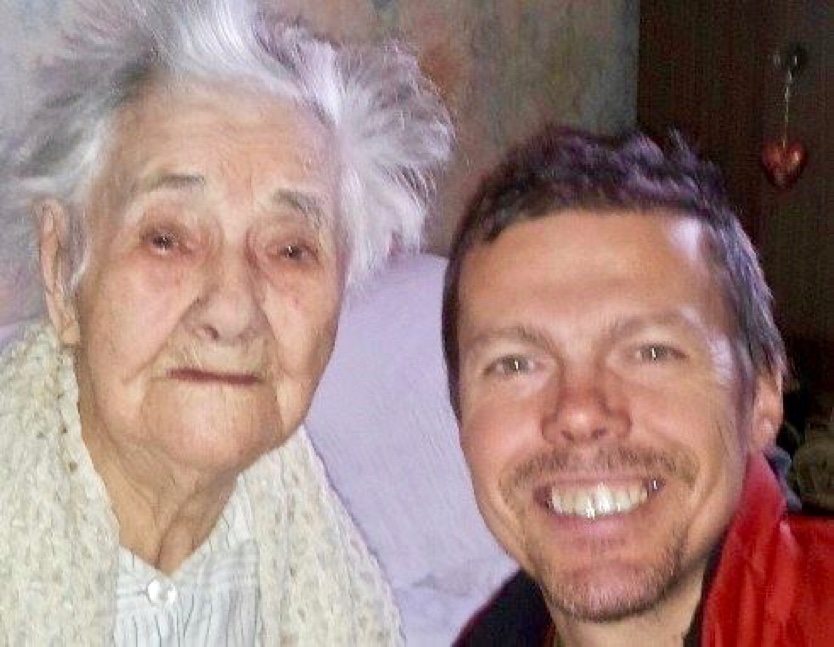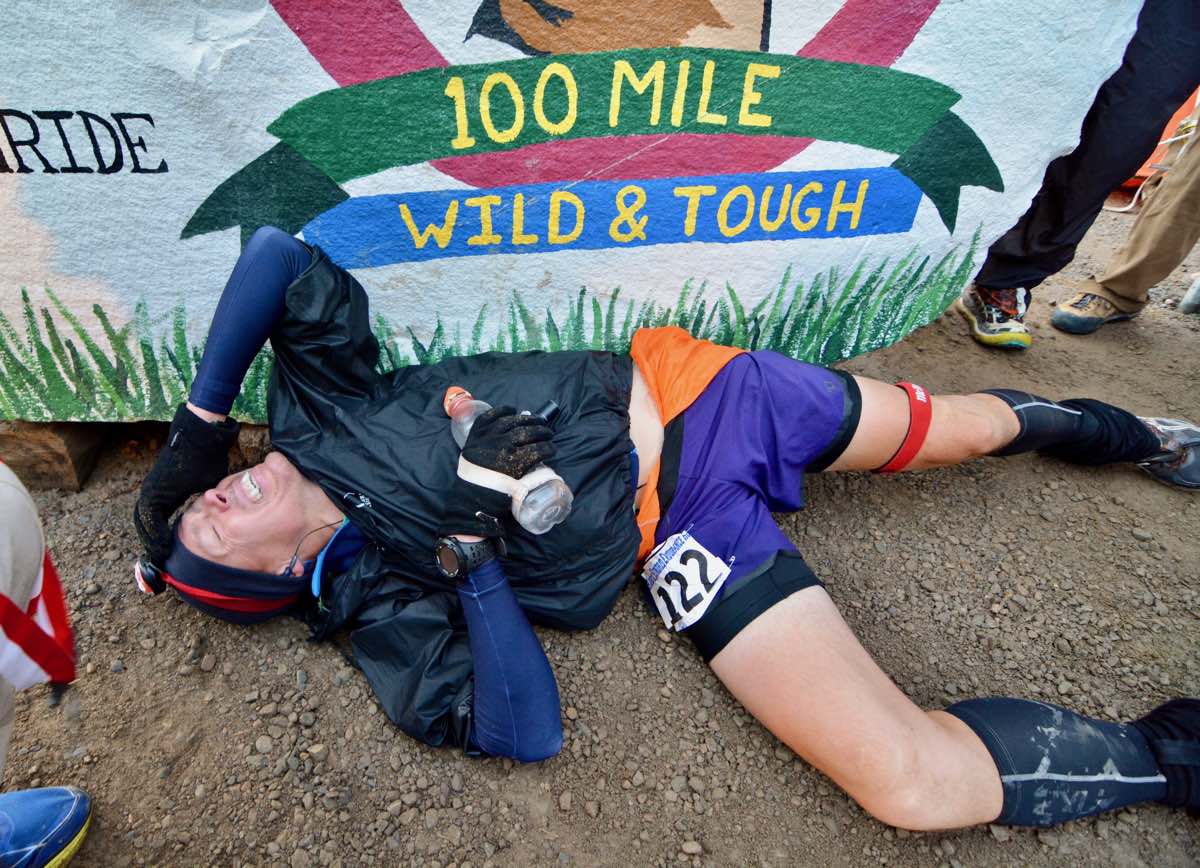[Editor’s Note: In 2015, Bogie Dumitrescu finished the Hardrock 100 in 47 hours, 59 minutes, and 59 seconds, one second before the 48-hour cutoff. Ahead of the lottery on Saturday for the 2019 edition, here is Bogie’s inspirational, down-to-the-second story.]
In 2015, I finished the Hardrock 100 in 47 hours, 59 minutes, and 59 seconds, one second before the 48-hour cutoff. My Hardrock finisher story is a series of intertwined micro-events, like cascading waterfalls, one subtle thing leading to another and then another, in which one moment could not have happened without the one before it. Any arbitrary turn along the way and my story would be different. To continue this waterfall metaphor, I’m just glad that water didn’t flow a a single second longer than it already did.
I began running on a whim at age 29, mostly because I saw people–including Jen Shultis, the well-known adventure racer and a dear friend of mine–trail running in Acadia, Maine. As a fabulous coincidence, I met Jen again about two weeks later, in the evening in the middle of a random park in Arcadia, Connecticut. If it wasn’t for Jen and those two very similarly named trail running locales, I would never have run at all.
Once I started running, I also signed up for an UltraRunning Magazine subscription and read in it an article about the Western States 100. I jumpstarted my training from nearly zero to a road marathon with the goal of running the Vermont 50 Mile and qualifying for Western States. Unfortunately, I got iliotibial band (IT band) tendinitis pretty much halfway through the marathon and that’s how I learned that I had a bum knee. My IT band became badly inflamed every time I ran fast or for more than 30 or 40 miles, especially on the downhills. So I frequently had to take four to six weeks completely off and then start training again. Training for ultramarathons is also how I met Steve and Deb Pero, and they introduced me to Hardrock. I applied for entry into Hardrock for five years in a row, and that was ‘years ago’ when there were only three people with two to the power of five tickets in the lottery.
Not getting into Hardrock for five years in a row was one of the best blessings in disguise. I wouldn’t have done the ‘Badwater Solo’ four times, and I wouldn’t have thought about the Arrowhead 135 Mile, either. And it was not likely that I would have finished Hardrock with my bad left knee and IT band.
In late 2014, I was drawn in the lottery for the 2015 Hardrock. Actually, I was approximately 15th on the waitlist in the Never Started category, which meant I had about a 50/50 chance to get in that year’s event. It was December and I was accepted in the Arrowhead 135 race, too, which was to be held the last weekend in January. I had to make a crucial decision–not if, but when I should get a special and rare knee surgery to release my IT band. After tossing and turning nonstop for about three weeks, I decided to have that surgery as soon as possible. This would allot me more recovery time for Hardrock, but it meant I had to give up on Arrowhead 135.
At this point in my ultrarunning career, I had enough experience on how to race, train, and avoid mistakes in training and racing. A few years prior I organized and attended the Colorado USATF Level 1 Running Coach certification. For my Hardrock training in the first half of 2015, I periodized, alternating high-mileage (120 miles per week) low-climb weeks with high-climb weeks (36,000 feet of climbing). The month before Hardrock, I totaled 106,677 feet of climbing. I mixed in some biking, recovery periods, and yoga. Even though I had hiked in Nepal to 17,500 feet with no acclimatization, I still acclimatized for Hardrock. I biked up the 14er Mount Evans in Colorado in the evenings and slept up there quite a few times during the eight weeks before the race. When race day arrived, I was confident that I was ready. In fact, I was so well trained that I was considering a double Hardrock.

The mountain bike I used to go up the 14er Mount Evans, and the minus-35-degree-Fahrenheit sleeping bag I used to sleep up at 14,000 feet. I did this many times before Hardrock to acclimatize. Photo: Bogie Dumitrescu
A week before the race, when I arrived to Silverton, Colorado, I stayed at the famous Avon, a hotel where Hardrockers and potential Hardrockers traditionally stayed and communed for at least 15 years. Avon has a common kitchen, and it just so happened that the only clean, available, empty mug I could find said ‘Grandma Silverton.’
A few hours after I chose that mug, my dad called to say that my grandma had died the day before, on Friday night, while I was driving to Silverton. My grandma had raised me since I was about eight or nine years old; she did everything for me. She was almost 101 years old and she died exactly one week before the Hardrock start. For the last 15 years, I had talked to her on the phone every Tuesday morning. She was bedridden for the last several years but her mind was still so sharp. I remember how often she told me that she was ready to go, but that it felt like she was waiting for something, that something was keeping her in this world. All week, my heart felt heavy, but I also couldn’t help but wonder if her passing at this exact moment was a message of strength for my journey to come.
When the race started, I stayed in the middle of the pack. Everything went perfectly until around the Sherman aid station at mile 30. After that, I started to feel my throat ‘clogging’ and began having breathing issues. Going uphill, my throat felt restricted, narrow, and inflamed. On those uphills, my breathing was rapid and shallow, which forced me to stop every 300 to 400 feet to take a few deep breaths and make sure I didn’t hyperventilate and pass out. The event manual prohibits hyperventilation and passing out on the course. (It doesn’t really say this, but maybe it should.)
I got to Grouse Gulch aid station and Blake Wood, a veteran Hardrocker taking the year off from the race due to his own knee surgery a couple months earlier, told me that based on how others had finished in previous years, I was already at the tail end of the 48-hour cutoff. I said something like, “What? That is impossible! I was doing so well for the first 30 miles that I was in the top third of the racers.” My breathing restrictions had caused me to drop to the back of the pack in only a few miles.
I was lucky to have Margaret Wood, daughter of Blake and pacer extraordinaire–like father, like daughter–from Grouse Gulch to Ouray. She was very patient and encouraging, and she knew how to motivate me gently to keep me going. I explained to her my problems and we tried to figure out why I could not breathe going uphill. At the same time, I ran all kinds of numbers in my head to see when I would finish. I was visualizing all the distances between aid stations, the uphills, and the downhills. I knew I would be slower at night and that I would slow down progressively. I determined that my finishing time would be between 47:30 and 48:30. This meant that nothing else could go wrong and I still might not finish in time.
I asked myself a million times, Why continue? Why do this? Why risk it? But every time I thought of dropping, I thought of my grandma and felt her presence out there, and I just kept going. From a rational point of view, the worst-case scenario was that I would miss a cutoff and time out. But I couldn’t find out if I’d finish unless I continued, so I went on.
Thinking about it then and even now, it is funny to hear people say that I had ‘elevation issues,’ or altitude sickness. At either Ouray or Telluride, the race staff checked my lungs and they were totally fine. They made sure I was okay–and that I could count all my 11 fingers–so they had no good reason to stop me. I knew it was not altitude sickness because I had trained so much between 11,000 and 14,000 feet. I biked up Mount Evans and slept there to acclimatize. And even when I went to Nepal at 17,000 feet, I never had a problem.
The thing that saved me was that I could breathe while running downhill. It wasn’t perfect but it was much easier and deeper. And with my recent surgery and my IT band and knee now feeling good, I blasted the downhills. I am talking about eight-minute miles on scree, rocks, and grass. I love downhills anyway. To give you an idea, running downhill from Kroger’s Canteen into Telluride, a distance of about five miles, I passed 15 people. But the uphills got harder and harder. I now had to stop every 100 feet or so, for five to 15 seconds to slow down my breath. My breathing was so bad that, had I found a thin PVC pipe, I would have used it as an endoscope tube. All this meant that I couldn’t stop for anything unplanned and unnecessary. I planned when I would take bathroom breaks and for how long. I was going in and out of the aid stations as fast as I could. I left my pack and anything not critical behind. I chased the cutoffs. I calculated the uphill distances and my pace, the downhill distances and my pace. On and on and on, nonstop. Though I was still many miles from realizing just how important a single second would be, I constantly told myself that I could not lose any second, anywhere.
I crossed Mineral Creek around 5 a.m., along with a French runner who had a pacer. I had about one hour to do the ‘easy and straightforward’ two miles from there to the finish before the 48-hour cutoff at 6 a.m. You run above the highway for about a mile on a trail affectionately called Nute’s Chute by Hardrockers. Then you turn left on a dirt road which brings you near the Shrine of the Mines. Down the trail into Silverton, a left and a right turn to the rock in front of Silverton’s school. Doable in an hour, even walking easy like I was.
Maybe I was tired, maybe it was meant to be, maybe both, but when I was supposed to make that left turn from the singletrack to the dirt road with a little less than a mile to go, I didn’t see any markers going left uphill on the road. Usually there is flagging before, at, and after a turn. So from Nute’s Chute, I went straight for at least five minutes on an old dirt road until I realized my mistake. I returned and righted myself, heading up a fairly steep hill on the dirt road. After another five minutes, I saw a driveway and a house, and I could not remember such things on this road. I looked back, hoping to see the French runner with his pacer, but saw nothing. I panicked, sure that I was lost, though I didn’t even know where I could have gotten lost. I am not sure why, but I started to run back downhill for another few minutes–which actually felt like an eternity. I finally saw the French runner and his pacer, so I turned around and headed uphill once more, all the time huffing and puffing and stopping for five to 10 seconds every 50 feet or so to catch my breath. (In case you were wondering, the French runner unfortunately finished several minutes after the cutoff.)
I finally got to the shrine and ran the singletrack downhill, thinking what a coincidence it was to finish near a shrine having had all these issues before and during the race, and with my grandma passing away a week ago. When I was behind the school, everybody was yelling and I could not understand a word they were saying. I was tired, and after my quiet two days on the Hardrock course, everyone sounded too loud. I thought people were cheering for me, but I would learn later that they were screaming about how close I was to the cutoff. I looked at my watch and it showed elevation, distance, pace, and an elapsed time of 47:55, but it did not show the time of the day. I thought that I was arriving with a couple minutes to spare. Only when I turned the corner and saw the official clock did I realize I was just seconds from the cutoff. I stopped, literally took a deep breath, and started sprinting while holding my breath. In the videos some spectators took, you can probably see me holding my breath. I did not look a second time at the race clock. Had I done that, had I hesitated, had I tripped, had I sneezed, or had I took a second breath, I would have lost at least another second. By the time I reached the rock, I almost passed out. My bib number was 122, I was the 123rd finisher, and I finished in 47:59:59.
Maybe 20 minutes later, I spoke to the finish-line medic and told them about my breathing issue. He used the stethoscope and said my lungs seemed totally fine. It took another two years, eight different doctors (a primary-care physician, two allergists, one pulmonologist, and four ear-nose-and-throat doctors), and a ton of blood tests, stress tests, breathing tests, and allergy tests until one ear-nose-and-throat doctor suggested a last-resort, ‘possible’ solution of removing my tonsils. I got the tonsillectomy, and poof, now I can breathe when it’s cold outside and my throat is fine.
This experience taught me that some things in life happen for a reason–and it is possible we won’t see for years the real reason why things do or don’t happen. It also taught me that one second can make a world of difference. So don’t quit, drop out, or give up, because you never know the outcome until you go ahead and try.
Call for Comments (from Meghan)
- Were you at the 2015 Hardrock 100 to see Bogie racing or finishing? What do you remember about those days and his finish?
- Have you ever continued on in an adventure or race even when things looked fairly grim? How and why did you find the strength to carry on?
- What lessons do stories like these from running teach us about life?




